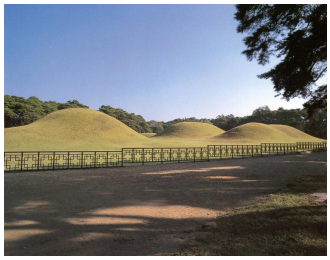1071 . Jinhan
Description

During the Samhan Period or the Proto-Three
Kingdoms Period, which refers to the period after
the fall of Gojoseon and before the maturation of
Goguryeo, Baekje, and Silla into full-fledged
kingdoms, the city-states of central and southern
Korean Peninsula were grouped into three
confederacies called Mahan, Jinhan, and Byeonhan.
Sam means three, and Han is a Korean word
meaning great or leader. The names of these
confederacies are reflected in the current name of
Korea, Daehan Minguk (literally, “Great Han
People's Nation”).
One of the city-states called Saro-guk, which was
established by King Park Hyeokgeose in 57 BCE,
around present-day Gyeongju, was the leader of
Jinhan confederacy. As the city-state expanded, it changed its name to Silla, which was the longest sustained
dynasty in Asian history. We knew little about other city-states of Jinhan confederacy, with the exception of
their names.
Recently, Prof. Choi, who is a highly considered archaeologist, announced that he had found the tomb of King
Park Hyeokgeose. By virtue of his major archaeological discovery, we get to know a little of the daily life of
Jinhan people. However, even the locations of city-states of Jinhan confederacy except for Saro-guk have
been not known as yet. Thanks to his success of deciphering the inscription engraved on the stone wall of the
tomb, the distances between some pairs of city-states of Jinhan confederacy including pairs between Saro-guk
and every other city-state have been known.
An ambitious research for estimating the locations of all city-states of Jinhan confederacy is initiated by Prof.
Choi and his research group. He conjectures that the city-states of Jinhan confederacy were located in a row.
His conjecture is based on the knowledge that Jinhan confederacy was located at between the Taebaek
Mountains and East Sea. To verify his conjecture, he develops a mathematical model, where the area occupied
by Jinhan confederacy is simplified into a straight line, say the x-axis, and the distance between two city-
states is represented by a positive integer. The location of a city-state can be described by a point on the x-axis. It is assumed that Saro-guk is located at the origin of the x-axis.
Prof. Choi wants to determine whether or not it is possible to locate all the city-states of Jinhan confederacy
on the x-axis subject to the distance constraints between the city-states. Of course, no two city-states should
occupy the same location. Write a program that can help him. We denote by n the number of city-states of
Jinhan confederacy, and assume that the city-states are numbered from 1 to n inclusive and thus no two city-
states have the same number. Saro-guk has a number of
1. The distances between some pairs of city-states
including pairs of Saro-guk and every other city-state are given as input.
For example, if n is equal to three, the distance between city-states numbered 1 and 2 is four, and the
distance between city-states 1 and 3 is also four, then it is possible to locate the city-states 1, 2, and 3 at positions 0, 4, and -4 on the x-axis, respectively. They can be located at positions 0, -4, and 4, too.
However, they cannot be located neither at positions 0, 4, and
4 nor at positions 0, -4, and -4.
Warn: 本題有 specialjudge
Input Format
Your program is to read from standard input. The input consists of T test cases. The number of test cases T is
given in the first line of the input. The first line of each test case contains two integers. The first integer,
n, is the number of city-states of Jinhan confederacy, and the second integer, m, is the number of pairs of city-
states whose distance is known, where 1<=n<=3000, and
1<=m<=300,000. In the following m lines, each
line contains three integers u, v, and d which represent that
u and v are known to be at a distance d apart, where
1<=d<=300,000,000.
Output Format
Your program is to write to standard output. Print exactly two lines for each test case. The first line of each
test case should contain the number n of city-states of Jinhan confederacy. It should follow the second line
containing the positions of city-states
1
,
2
,
...
, and
n
in order if they can be located on the x-axis satisfying
all the mentioned conditions; otherwise, it should contain just impossible. If there are multiple solutions,
pick any one of them.
Sample Input 1
3 3 2 1 2 4 1 3 4 3 3 1 2 4 3 2 4 3 1 4 4 6 1 2 1 2 3 1 3 4 1 1 3 2 2 4 2 4 1 3
Sample Output 1
3 0 4 -4 3 impossible 4 0 1 2 3
Hints
Problem Source
Migrated from old NTUJ.
2009Seoul
Subtasks
| No. | Testdata Range | Score |
|---|